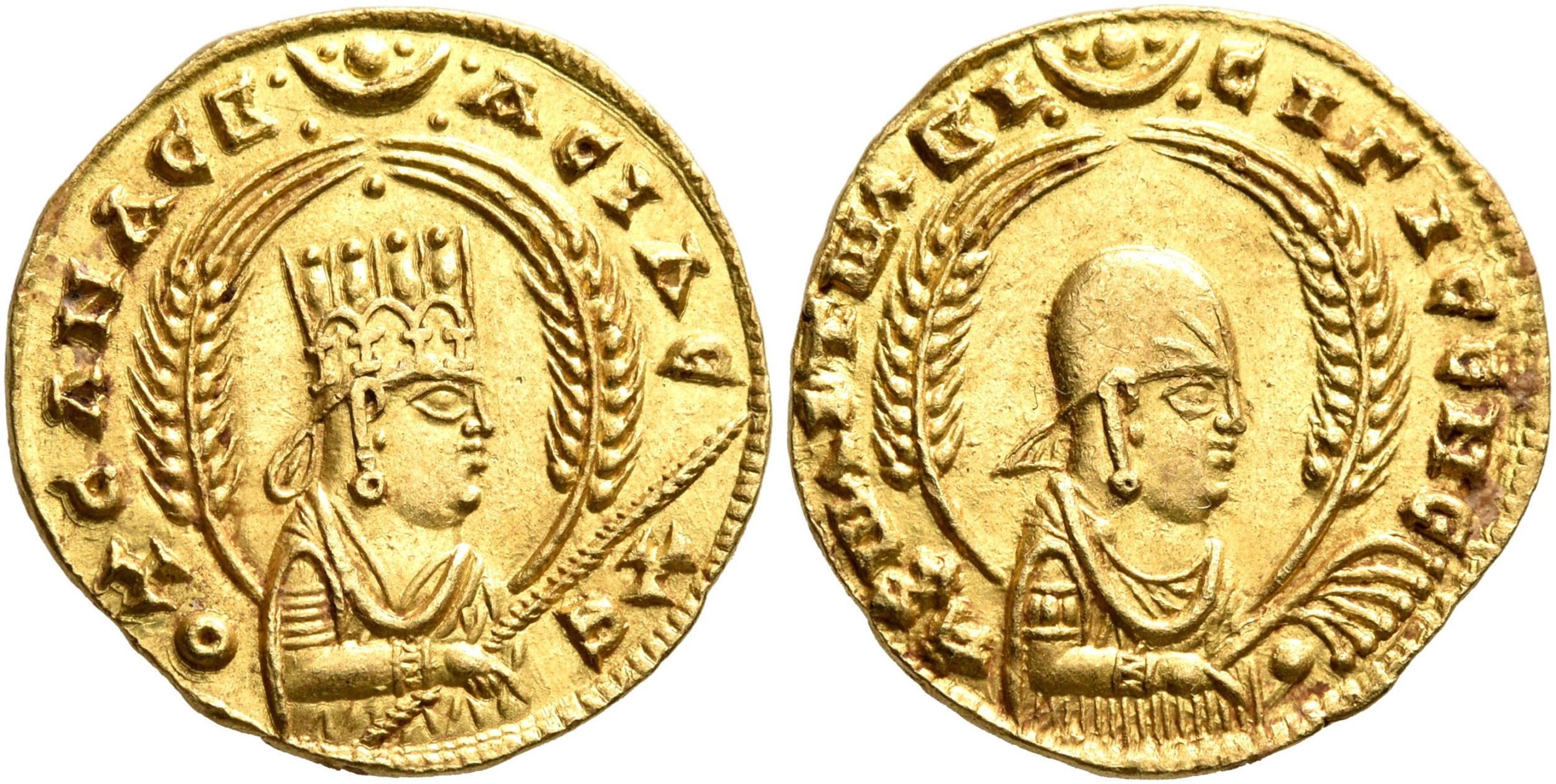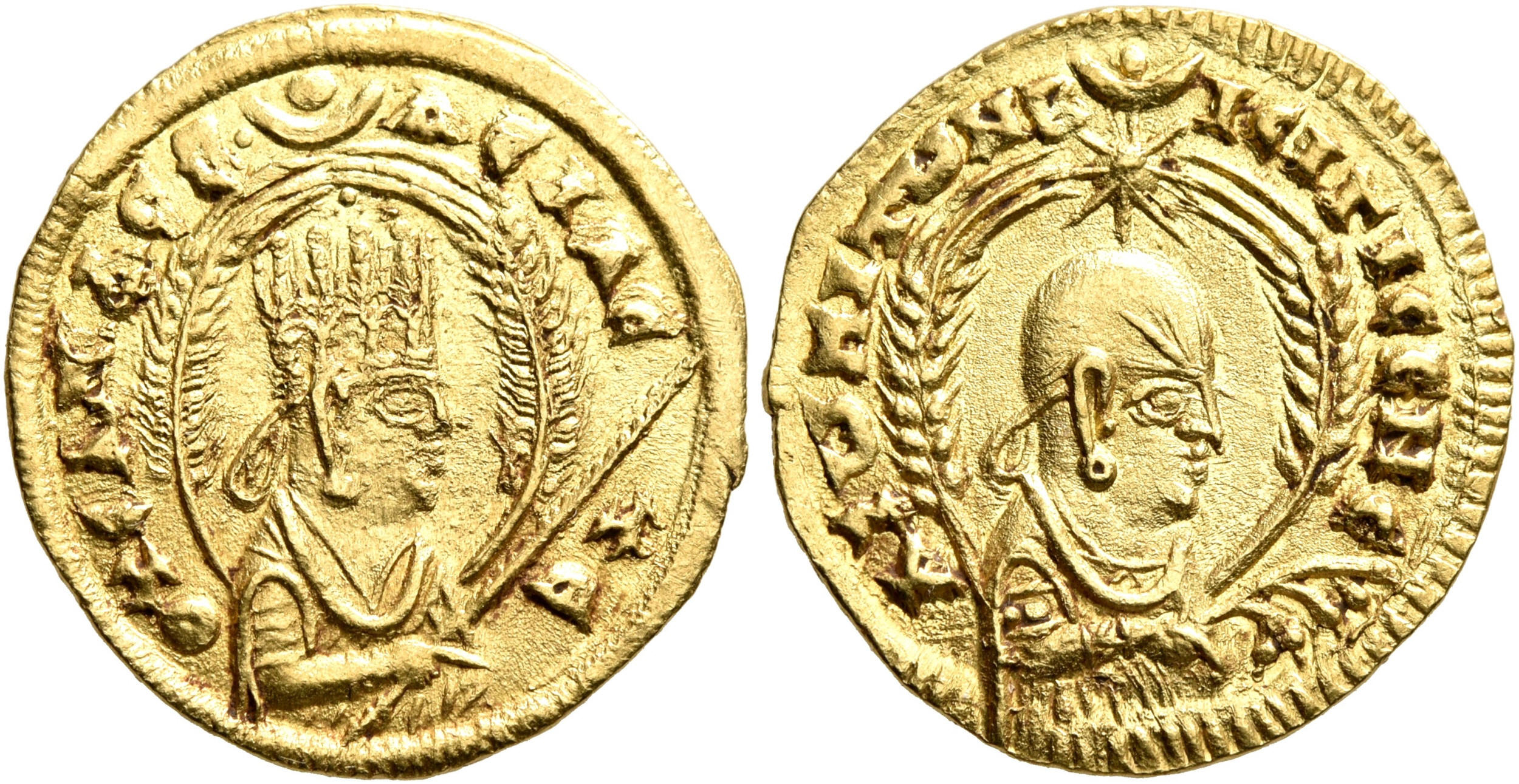

Ousanas I, circa 325-345. Chrysos (Gold, 17 mm, 2.27 g, 12 h). ΟΥCΑΝAC Β-ACIΛЄ-ΥC Draped half-length bust of Ousanas I to right, wearing long garment, tiara and circular earring, holding spear in his right hand and with bracelets on his right arm; to left and right, ears of barley; above, pellet and pellet in crescent surrounded by six pellets. Rev. ΑξⲰΜΙΤⲰΝ BI-CI ΓΙCЄΝЄ Draped half-length bust of Ousanas I to right, wearing long garment, tight-fitting head cloth and circular earring, holding branch in his right hand and with bracelets on his right arm; to left and right, ears of barley; to lower right, pellet; above, pellet in crescent surrounded by four pellets. Hahn, Aksumite, 12a. Hahn & Keck, MAKS, 14. Munro-Hay, AC, type 24. A magnificent piece, very sharply struck and undoubtedly among the finest Axumite gold coins in existence. Good extremely fine.
From the Dr. Stephan Coffman Collection.
It was probably under Ousanas I (who may also have been called Ella Amidas, not to be confused with the later Alla Amidas) that Christianity was first introduced in Axum by Frumentius, one of two Roman boys reportedly captured after a raid on a ship docked at an Axumite harbor (for the full story, see lot 296 below). Munro-Hay suggested that this sudden aggression resulted from the death of Licinius I in 324, which could temporarily have led any treaties between Rome and Axum to lapse. However, this is perhaps an overinterpretation, as occasional acts of piracy were commonplace in Antiquity, certainly in such distant and contested regions as the Red Sea.
In any case, relations between the Axumites and the Empire remained close, and Ousanas lowered the weight of his chrysoi to accord with that of Constantine I's solidi (the chrysoi now circulating as half solidi, or semisses), no doubt to facilitate trade. Inscriptions imply that Ousanas enjoyed a long reign, and Hahn & Keck (MAKS, p. 70-71) have suggested that the pellets surrounding the crescents may indicate regnal years, with the large pellet on the bottom right of the reverse symbolizing a ten. Tempting as such an interpretation is, it does seem rather speculative, and we should perhaps accept that we do not know the meaning of the pellets. Despite (or because of?) its longevity, Ousanas' reign appears to have been troubled by political turbulence towards the end, as a usurper called Wazeba may have claimed the throne (see lot 289 below).
Leu, okt. 2023, lot 279, 8000 CHF (Euro 8417)

Ousanas I, circa 325-345. Chrysos (Gold, 18 mm, 2.20 g, 12 h). ΟΥCΑΝAC Β•-ACIΛЄ-ΥC Draped half-length bust of Ousanas I to right, wearing long garment, tiara and circular earring, holding spear in his right hand and with bracelets on his right arm; to left and right, ears of barley; above, pellet and pellet in crescent. Rev. ΑξⲰΜΙΤⲰΝ B-ICI ΓΙCЄΝЄ Draped half-length bust of Ousanas I to right, wearing long garment, tight-fitting head cloth and circular earring, holding branch in his right hand and with bracelets on his right arm; to left and right, ears of barley; above, star and pellet in crescent. Hahn, Aksumite, 12b. Hahn & Keck, MAKS, 15. Munro-Hay, AC, type 22. An extremely rare variety with a star on the reverse. Struck from slightly worn dies, otherwise, good extremely fine.
From the Dr. Stephan Coffman Collection.
Hahn & Keck have suggested that the remarkable star on the reverse of this coin might refer to the planet Jupiter and celebrate Ousanas' vicennalia. Interestingly, it occupies the same place as the monogram does on the chrysoi of the presumed usurper, Wazeba (see lot 289 below). Taking this into account, the star might also have been Ousanas' personal emblem, an idea strengthened by the fact that no other king repeated its use.
Leu, okt. 2023, lot 280, 8500 CHF (Euro 8943)